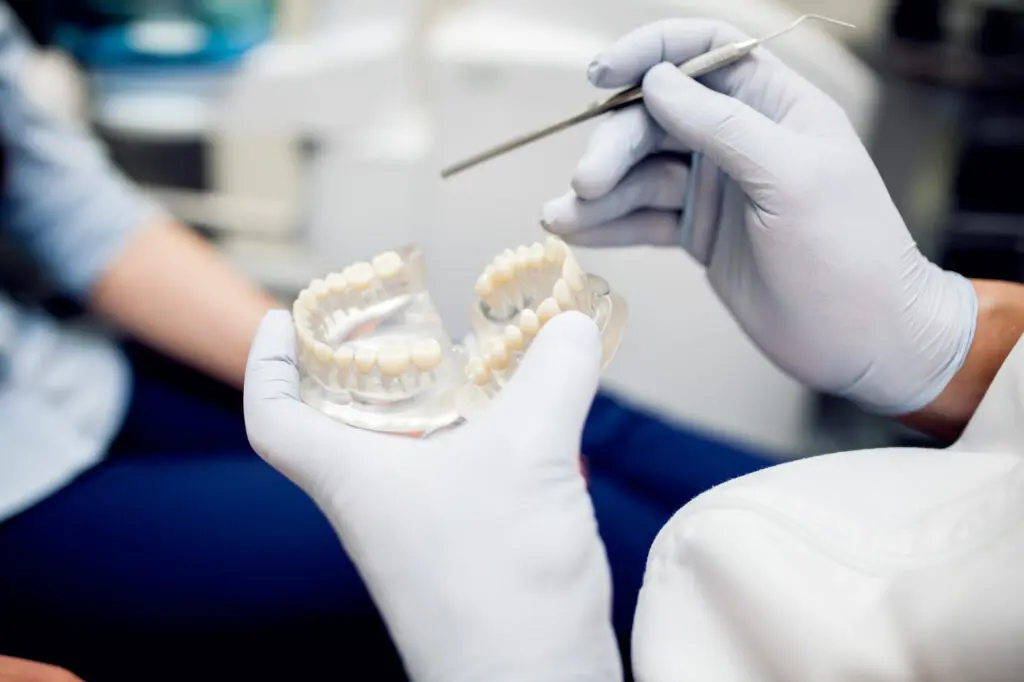If you’re living in East Lansing and have missing teeth, you may have heard your dentist mention the term “bridgework.” It might sound unfamiliar or even a little intimidating, but there’s no need to worry as it is very simple.
At Schaefer Dental East Lansing, we believe in making dental care simple, understandable, and stress-free. In this guide, we’ll let you know in detail about dental bridgework: what it is, when it’s needed, what the treatment involves, and how it can improve your smile and quality of life.
Even if you’re considering your first restoration or looking to replace an older bridge, our experienced dental team is here to restore your smile’s look, feel, and function with care you can trust completely.
What Is Bridgework in Dentistry?
Bridgework refers to a fixed dental restoration that replaces one or more missing teeth. A dental bridge quite literally “bridges” the gap where teeth have been lost, using your existing teeth or implants as anchors to hold a false tooth (or teeth) in place.
A typical bridge consists of:
- Crowns placed on the natural teeth (or implants) on either side of the gap.
- An artificial tooth, called a pontic, which fills the empty space.
Bridgework not only restores the aesthetics of your smile but also helps maintain proper bite alignment and provides support to everyday functions like chewing and speaking.
When Is Bridgework Recommended?
Our dentists often recommend bridgework for patients who have one or more missing teeth, especially if the gap is creating difficulties with chewing, speech, or appearance.
Common reasons to consider bridgework include:
- A visible gap that affects your smile confidence.
- Trouble chewing certain foods or speaking clearly.
- Preventing remaining teeth from drifting out of place.
- Maintaining a healthy bite and jaw alignment.
- Preserving facial structure by supporting the cheeks and lips.
Even a single missing tooth can cause long-term oral health issues. Bridgework provides a practical, long-lasting way to keep your smile stable and functional.
Types of Dental Bridges
Not all bridges are the same. Depending on your needs, your dentist will recommend the most suitable type of bridgework for your situation:
Traditional Bridge
This is the most common type. It uses crowns placed on both adjacent teeth to support the pontic. Traditional bridges are strong and reliable, especially for molars.
Cantilever Bridge
Used when there’s only one healthy adjacent tooth. This type is less common and is usually reserved for areas with lower bite pressure.
Maryland Bridge
Also known as a resin-bonded bridge, this type uses a metal or porcelain framework bonded to the back of adjacent teeth, instead of crowns. It’s typically used for front teeth where less chewing pressure is applied.
Implant-Supported Bridge
When several teeth are missing, a bridge can be anchored using dental implants instead of natural teeth. Implant-supported bridges are extremely stable and do not rely on adjacent teeth for support, making them ideal for larger gaps.
Explore more on our crowns and bridgework services in East Lansing.
The Bridgework Process: What Patients Can Expect
Are you confused about how the process looks? Let’s have a look at what to expect during dental bridgework at Schaefer Dental East Lansing:
Initial Consultation
Your dentist will examine your teeth, take X-rays, and discuss your options. We’ll determine whether a bridge is the right solution or if another treatment (like implants or dentures) might suit you better.
Tooth Preparation
If a traditional bridge is selected, the supporting teeth will be carefully reshaped to make room for crowns. Impressions are taken to create a model for your custom bridge.
Temporary Bridge
A temporary bridge is placed to protect the area while your permanent one is crafted in a dental lab. This typically takes 1–2 weeks.
Final Placement
Once your permanent bridge is ready, we’ll check the fit, make adjustments as needed, and cement it into place. You’ll leave with a fully restored, natural-looking smile.
Timeline: Most patients complete the bridgework process in 2–3 appointments over a span of 2–3 weeks.
Benefits of Dental Bridgework
Dental bridgework offers more than just a cosmetic fix as it has functional and long-lasting benefits:
- Restores a natural-looking smile
- Improves chewing and speech
- Prevents teeth from shifting out of place
- Maintains facial structure and jaw alignment
- Boosts self-esteem and confidence
- Durable with proper care as it can last 10–15 years or more
Caring for Your Dental Bridge
Proper care is key to maximizing the lifespan of your bridgework.
Here’s how to care for your bridge at home:
- Brush twice daily with fluoride toothpaste.
- Floss daily, especially under and around the bridge. A floss threader or water flosser can make this easier.
- Avoid sticky or hard foods, especially during the adjustment period.
- Visit your dentist regularly for cleanings and checkups.
Well-maintained bridgework can last many years and protect your surrounding teeth from damage.
Is Bridgework Right for You?
While bridgework is a great solution for many patients, it may not be ideal for everyone. The best choice depends on your oral health, bone structure, lifestyle, and goals.
You may need it if:
- You have healthy teeth on one or both sides of a missing tooth.
- You want a fixed (non-removable) option.
- You’re not ready for implants or prefer a quicker, less invasive option.
In some cases, alternatives like dental implants or removable partial dentures may be more appropriate. That’s why we always recommend a personalized consultation to determine the best fit for your smile.
If you’re living with one or more missing teeth, bridgework is a reliable, proven way to restore your smile and protect your long-term oral health. At Schaefer Dental East Lansing, we’re proud to offer custom solutions that are functional and look completely natural.
From consultation to final placement, our skilled dental team is here to make your experience comfortable, convenient, and results driven.
Ready to take the first step? Contact us today to schedule your consultation and find out if dental bridgework is the right fit for your smile.
Learn more about our crowns and bridgework services and how we can help you smile with confidence again.


